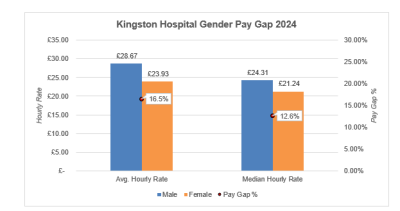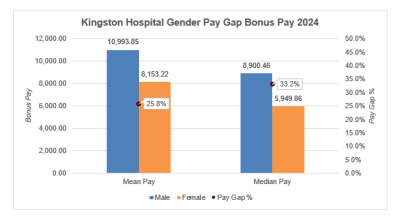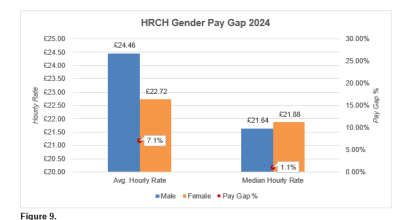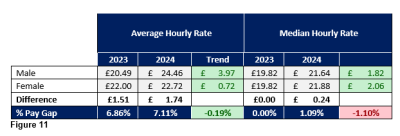Equality, Diversity and Inclusion reports
Executive Summary
Kingston Hospital NHS Foundation Trust (KHFT) gender pay gap figures for the snapshot date of 31st March 2024 show, a mean gap of 16.5% and a median figure of 12.6%. There has been a slight reduction of 1.3% in the mean pay gap and a more significant decrease in the median pay gap of 3% from 2023. This is a positive shift towards closing the median pay gap.
KHFT gender pay gap figures for March 2024 is shown in the tables below:
Hounslow & Richmond Community Healthcare gender pay gap figures for the snapshot date of 31st March 2024 show, a mean gap of 7.1% and a median figure of 1.1%. There has been a slight reduction of 0.19% in the mean pay gap from last year. Also, last year the median pay gap was 0% and this year the figure has increased marginally to show a pay gap of 0.19%. However, for the first time this pay gap is in favour of female employees as the median hourly rate of pay for females is £21.88 which is £0.24 pence higher than median hourly rate of pay for male employees at 21.64.
HRCH’s gender pay gap figures for March 2024 is shown in the tables below:
The main reason for the gender pay gap is because there is a high proportion of male employees in the highest earning quartile. Another reason for the gender pay gap is that more men than women receive bonuses. The bonus gap has been driven largely by the National Clinical Impact Awards (NCIAs), previously known as Clinical Excellence Awards (CEAs), which were awarded to medical and dental staff. NCIAs will not be directly included in the general NHS pay awards in future due to national changes, and this may support addressing the gender pay gap for medical and dental staff.
We will continue to address the gender pay gap and put in place additional actions such as inclusive recruitment and selection practices and career development programs to support the advancement of female staff.
Introduction
This report provides the gender pay gap data for the former organisations Kingston Hospital NHS Foundation Trust (Kingston Hospital) and Hounslow and Richmond Community Healthcare Trust (HRCH). A disaggregation of Hounslow and Richmond Community Healthcare Trust took place in July 2024 with Richmond-based staff merging with Kingston Hospital NHS Foundation Trust in November 2024. The new Trust is now Kingston and Richmond NHS Foundation Trust. In accordance with the requirements of the Government Equalities Office the data for the former Trusts must still be reported for this period.
The Equality Act 2010 (Specific Duties and Public Authorities) Regulations 2017 require public bodies with 250 or more employees on the snapshot date of 31st March of any given year to report their gender pay gap.
It is important to note that the gender pay gap is different to equal pay.
Equal pay deals with pay differences between men and women who carry out the same jobs, similar jobs or work of equal value. It is unlawful to pay people unequally because they are a man or a woman.
The gender pay gap shows the difference between the average (mean or median) earnings of men and women. It is expressed as a percentage of men’s earnings.
A positive percentage figure reveals that typically, or overall, females have lower pay or bonuses than male employees. Whereas a negative figure reveals that males have lower pay or bonuses. A zero-percentage figure would indicate no gap between the pay or bonuses of typical male and female employees.
This gender pay gap exists because women tend to work in lower-paid occupations and sectors and occupy fewer senior roles. Women are more likely to take time out of the labour market and work part-time to undertake caring responsibilities. Stereotypes and workplace culture are also factors that can affect the gender pay gap.
Used to its full potential, gender pay gap reporting is a valuable tool for assessing levels of equality in the workplace, female and male participation, and how talent is being maximised.
- The regulations require that the following calculations are completed:
- The mean gender pay gap
- The median gender pay gap
- The mean bonus gender pay gap
- The median bonus gender pay gap
- The proportion of males receiving a bonus payment
- The proportion of females receiving a bonus payment
- The proportion of males and females in each quartile pay band.
-
- The calculations make use of two types of averages:
- The mean, commonly known as the average, is calculated when you add up the wages of all employees and divide the figure by the number of employees. The mean gender pay gap is the difference between mean male pay and mean female pay. For example, if the hourly gender pay gap at a company is 32%, then for every £100 earned by a man a woman would earn £68.
- The median is the figure that falls in the middle of a range when everyone’s wages are lined up from smallest to largest. The median gap is the difference between the employee in the middle of the range of male wages and the middle employee in the range of female wages.
- The median is typically a more representative figure as the mean can be skewed by outlying figures. A large difference between the mean and the median can be indicative of inequality at either end of the pay spectrum.
- The calculations make use of two types of averages:
-
- The results from the above calculations must be displayed on the Trust’s website and be maintained for a minimum of three years, although the Trust could decide to maintain it for longer than this in order to demonstrate long-term progress.
-
- This report sets out the above calculations as at the snapshot date of 31st March 2024.
Kingston Hospital NHS Foundation Trust's Gender Pay and Bonus Pay Gap
Kingston Hospital Gender Pay Gap and Pay Quartiles
The full dataset of full-pay relevant employees totalled 4,032 of these 1,018 being male (25%) and 3,014 being female (75%). The gender split has broadly remained the same in the last 5 years with a variation of 1%.
Kingston Hospital’s gender pay gap figures for the snapshot date of 31st March 2024 show, a mean gap of 16.5% and a median figure of 12.6%. There has been a slight reduction of 1.3% in the mean pay gap and a more significant decrease in the median pay gap of 3% from 2023. This is a positive shift towards closing the median pay gap.

The figures for March 2024 and the change from the previous year are shown in the tables below.
Gender pay gap headline figures for March 2024.

The main reason for the gender pay gap is because there is a higher proportion of male employees in the highest earning quartile. The pay quartiles for all 3,845 relevant full-pay employees are shown below in figure 4. This shows that the highest proportion of male employees (35.7%) are in the upper pay quartile. Whereas the highest proportion of female employees are in the Lower Middle quartile at 79.8%.

Kingston Hospital's Bonus Gender Pay Gap
Bonuses, as defined by the regulations, include anything that relates to profit sharing, productivity, performance, incentive and commission. They can be received in the form of cash, vouchers, securities, securities options, and interests in securities. Non-consolidated bonuses are included.
For this analysis, the bonus gender pay gap has been calculated with regard to the payment amounts made under the National Clinical Impact Awards (NCIAs), previously known as Clinical Excellence Awards (CEAs). In line with the regulations all payments made during the 12-month period ending with 31st March 2024 have been incorporated. That is payments made during the period 1st April 2023 to 31st March 2024. Further, in line with the regulations, all such bonuses received within this period have been included regardless of the period to which the bonus is attributed.
The 2024 bonus gender pay gap and data is shown below:

Figure 6 above shows the proportion of male relevant employees who were paid any amount of bonus pay during this period was 4.03.%, the comparable figure for females was 0.86%. This shows a disparity of 3.17% which is 0.43% less than the previous year.
The figures for the bonus gender pay gap for March 2024 and the change from previous years are shown in figures 7 and 8 below.

The mean bonus pay gap for 2024 is 25.84% which is an increase of 1.13% from 2023. The median pay gap figure has reduced slightly by 0.18% for the first time in over 3 years.
It should be noted that for this reporting period there was no competitive process applied for the National Clinical Impact Awards (NCIAs, previously Clinical Excellence Awards / CEAs). This was also the same for the previous year. Payments were made to all eligible substantive Consultants with 1 years’ service in the 2003 consultant grade by 1st April 2023 at Kingston Hospital. Eligible Consultants received a proportional amount based on whole time equivalent (WTE), as a one off non-consolidated, non-pensionable payment.
The gender bonus pay gap calculations are based on the bonus pay received during the period, regardless of whether this pay has been reduced because the individual works part-time. As CEAs are paid on a pro-rata basis this is an important consideration to make as female award recipients are more likely work part-time compared to male recipients.
The reason for the bonus pay gap is largely due to the underrepresentation of female doctors in highest paid jobs, grades and specialities. Also, female doctors are more likely to take time out of work for childcare responsibilities which can have an impact on their career progression.
Hounslow and Richmond Community Healthcare NHS Trust's Gender Pay and Bonus Pay Gap
HRCH Gender Pay Gap and Pay Quartiles
The full dataset of full-pay relevant employees totalled 1,489 of these 236 being male (16%) and 1,253 being female (84%). The gender split has changed slightly since last year when it was female 80.1% and male 19.9%
HRCH’s gender pay gap figures for the snapshot date of 31st March 2024 show, a mean gap of 7.1% and a median figure of 1.1%. There has been a slight reduction of 0.19% in the mean pay gap from last year. Also, last year the median pay gap was 0% and this year the figure has increased marginally to show a pay gap of 0.19%. However, for the first time this pay gap is in favour of female employees as the median hourly rate of pay for females is £21.88 which is £0.24 pence higher than median hourly rate of pay for male employees at 21.64.

The figures for March 2024 and the change from the previous year are shown in figures 10 and 11 below.
Gender pay gap headline figures for March 2024

The main reason for the mean gender pay gap is because there is a high proportion of male employees in the highest earning quartile. The pay quartiles for all 1,489 relevant full-pay employees are shown below in figure 12. This shows that the highest proportion of male employees (19.8%) are in the upper pay quartile. However, the highest proportion of female employees are in the upper middle quarter at 89.2% which would explain the median pay gap figure in favour of female employees.

HRCH Bonus Gender Pay Gap
Bonuses, as defined by the regulations, include anything that relates to profit sharing, productivity, performance, incentive and commission. They can be received in the form of cash, vouchers, securities, securities options, and interests in securities. Non-consolidated bonuses are included.
For this analysis, the bonus gender pay gap has been calculated with regard to the payment amounts made under the NCIAs. In line with the regulations all payments made during the 12-month period ending with 31st March 2024 have been incorporated. That is payments made during the period 1st April 2023 to 31st March 2024. Further, in line with the regulations, all such bonuses received within this period have been included regardless of the period to which the bonus is attributed.
The 2024 data is shown below:


Figures 13 and 14 above show the amount of bonus pay paid and the proportion of relevant employees who were paid any amount of bonus pay during this period. This year there were only female employees that received bonus pay and no male employees. This is because there were no male employees eligible for NCIAs / CEAs for this period.
The same applied in 2023, therefore without comparable data for male employees, no bonus gender pay gap can be calculated.
Conclusion and next steps
This report provides an account of the gender pay gap and bonus gender pay gap data for the former Trusts Kingston Hospital NHS Foundation Trust and Hounslow and Richmond Community Healthcare NHS Trust. Whilst these Trusts have merged in the majority as good practice an action plan has been developed to support the new Trust Kingston and Richmond NHS Foundation Trust in continuing its work to close the gender pay gap. Gender pay gap data for Kingston and Richmond NHS Foundation Trust will not be available until 1st April 2025. Once this data is available the Trust will review and update its action plan accordingly.
The action plan below in Appendix 1 outlines how the Trust proposes to reduce the gender pay gap over the coming year in line with its EDI High Impact Action plan.
The table below provides the current actions in place to support improvement of the Trust’s gender pay gap. These actions will be refreshed in 2025 as part of our wider equality, diversity and inclusion objectives and plans.
|
EDI Objective |
Action(s) |
Progress |
Timeframe |
Accountable Lead |
|
Staff Networks – We will continue to support our staff networks as a safe way for staff to have peer support and open conversations. |
Consider setting up a women’s network to support our female workforce. |
Terms of reference to be proposed to the new EDI working group. |
Q3 |
Deputy Chief People Officer – EDI & People Strategy |
|
Leadership – develop inclusive and compassionate leadership to support a diverse workforce. |
Provide Leadership Development programmes that support women and staff with other protected characteristics into leadership roles, both managerial and clerical |
Senior Leadership programme is running, however not targeted at women. New apprenticeship academy has been launched across both Trusts to provide development pathways. Ongoing evaluation of apprenticeship uptake will include reporting by gender and where necessary remedial action will be taken if required to improve uptake amongst female staff. |
Ongoing |
Deputy Chief People Officer – OD & Wellbeing and Deputy Chief People Officer – EDI & People Strategy |
|
Deliver campaigns and events that focus on women’s achievements in healthcare |
Planned promotion and celebration of International Women’s Day 2025 |
Q1 |
Deputy Chief People Officer – EDI & People Strategy |
|
|
Debias Recruitment & Selection |
Ensure recruitment panels are gender balanced |
We will continue to build the progress that has already been made with Recruitment Inclusion Specialists continuing to sit on interview panels for band 7 and above roles. |
Ongoing |
Deputy Chief People Officer – EDI & People Strategy |
|
Review Recruitment and selection practices |
Following a comprehensive review of recruitment practices, we will introduce robust actions to support a fair and inclusive recruitment process. We anticipate this will improve the experience of candidates’ recruitment within our organisation. Ensure that executive search agencies supporting the recruitment to senior roles are working to a brief that includes clear criteria in relation to gender balanced shortlists (and other protected characteristics). Support women to return to work in a variety of different work patterns and employment models, further promoting flexible working approach. Continue to promote family friendly policies. |
Q3 |
Deputy Chief People Officer – EDI & People Strategy and South West London Recruitment Hub |
|
|
Health and Wellbeing |
Menopause workshops |
The trust has held threemenopause workshops, alongside menopause clinics twice a month. The menopause support group has held 12 sessions during the reporting period. This work will continue and provide further support to staff and managers. A new staff guide on menopause has been produced and circulated to staff. |
On-going |
Deputy Chief People Officer – OD & Wellbeing |